Passive Cooling Design for NVIDIA Jetson Platform, Enhanced Thermal Management
Have you ever been engrossed in a demanding task on your NVIDIA Jetson platform, only to be interrupted by the sudden whir of a cooling fan springing to life? The abrupt transformation of your quiet device into a bustling airstrip, reminiscent of a miniature plane preparing for takeoff, can be quite surprising. Similarly, the sensation of accidentally touching a scorching hot lightbulb, resulting in burned fingers, can mirror the consequences of inadequate thermal management in embedded systems.
An overly enthusiastic fan might seem like a solution, but it could inadvertently introduce a concentrated surge of warmth, leaving critical components toastier than anticipated.
Enter the realm of passive cooling—a sophisticated approach that addresses both noise concerns and localized overheating. Hardware engineers have introduced innovative tools to efficiently manage the thermal energy generated by NVIDIA Jetson platforms through passive cooling methods such as heat sinks, heat pipes, and natural convection. These strategies effectively dissipate heat without relying on power-hungry fans, leading to enhanced power efficiency, reduced maintenance demands, and suitability for rugged environments where contaminants might disrupt active cooling mechanisms.
Overall, passive cooling aligns seamlessly with safety requirements in hazardous settings, making it an indispensable strategy for optimizing embedded systems’ performance, size, and reliability. We’ll cover how we design the system for the NVIDIA Jetson platform:
- heat dissipation requirement;
- heat dissipation effect simulation;
- passive cooling mechanical design
- testing on Jetson Xavier NX, Orin Nano, and Orin NX modules.
Passive cooling system for NVIDIA Jetson
Passive Cooling Requirements:
Design Specifications:
- Full Load Heat Generation: 25W
- Maximum Ambient Temperature: 60°C
- Allowable Temperature Rise for Heat Source: 20°C
- Device Orientation: Vertical and Horizontal
- Cooling Method: Passive Cooling (Natural Convection)
Heat dissipation emulation
For optimizing heat dissipation, the integration of heat fins is employed as a potent passive cooling mechanism.
The calculation of heat dissipation area follows the equation Q = KAΔt:
Q: Power consumption (W)
K: Heat transfer coefficient (W/(m²℃))
A: Heat dissipation area (m²)
Δt: Temperature rise (℃)
The calculation process is as follows: Q = 23.4, K = 25, Δt = 20
These calculations yield a heat dissipation area A of 0.05 m². Consequently, the necessary heat dissipation area for the upper cover is deduced to be 0.05 m². Subsequently, Figure.1 shows the fin height is computed to be approximately 15 mm, possessing a thickness of about 2.5 mm, with an aggregate count of 17 fins.
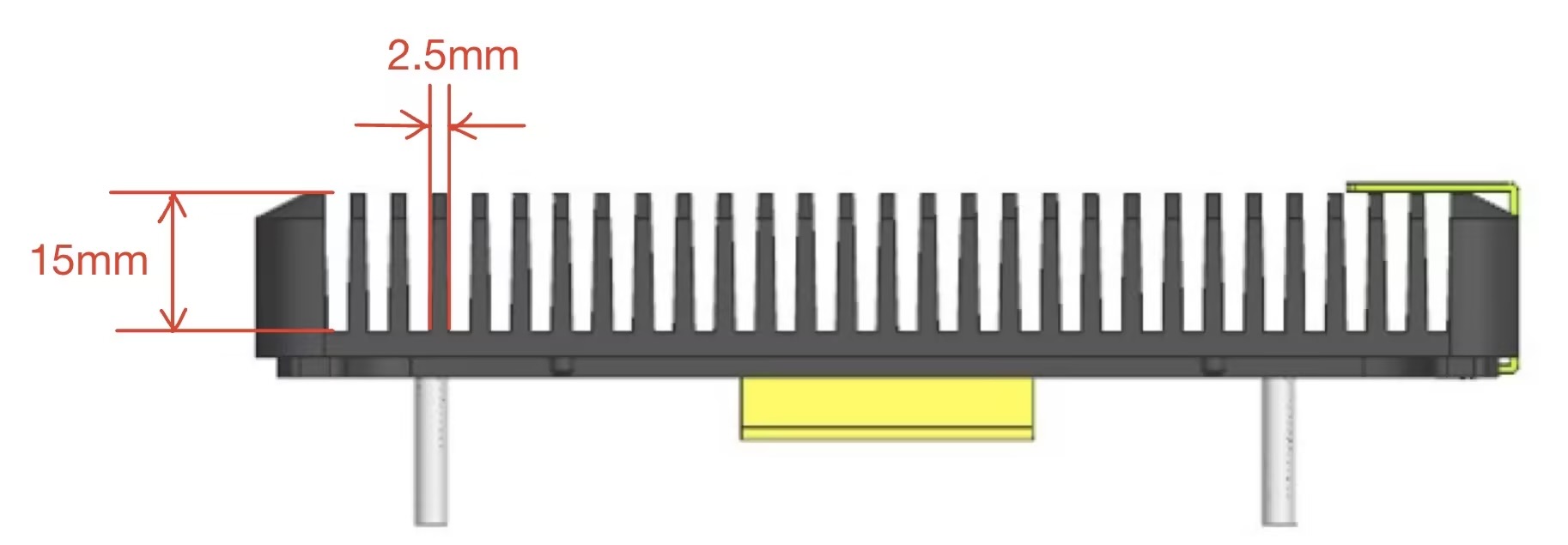
Regarding material selection, the augmentation of heat dissipation efficiency is pursued through the adoption of 6063 aluminum alloy and SPCC as the designated heat dissipation materials. Concurrently, the introduction of heat pipes and copper blocks bolsters heat transfer rates.
The resultant comprehensive temperature map reveals the CPU temperature to be approximately 86.86℃.
Testing and Refinement on NVIDIA Jetson Modules
Despite meticulous simulation and rigorous testing, it became evident that the current cooling solution did not meet the initial heat dissipation target as anticipated.
Consequently, a course of action was taken: the height of the heat fins was adjusted from the initial 15mm to a revised height of 17mm. Following this adjustment and a subsequent round of simulation, the outcome unveiled a maximum CPU temperature of 79.48°C, effectively aligning with our predefined requirements.
Leveraging Passive Cooling for Dynamic Thermal Management on the Jetson Orin Module
Jetson Orin Module enables a wide variety of applications that may exercise different components on the module. The variation between applications will cause variations in heat loads on the different components of the Jetson Orin module. It will also cause hotspots in different logical partitions of the Orin SoC. While the system thermal solution will help to spread the heat and make the thermal performance as consistent as possible, different applications will have different levels of thermal performance. The more evenly the module power is distributed across the Jetson Orin module the higher the thermal performance will be.
Enclosure Mechanical Design
Heat dissipation
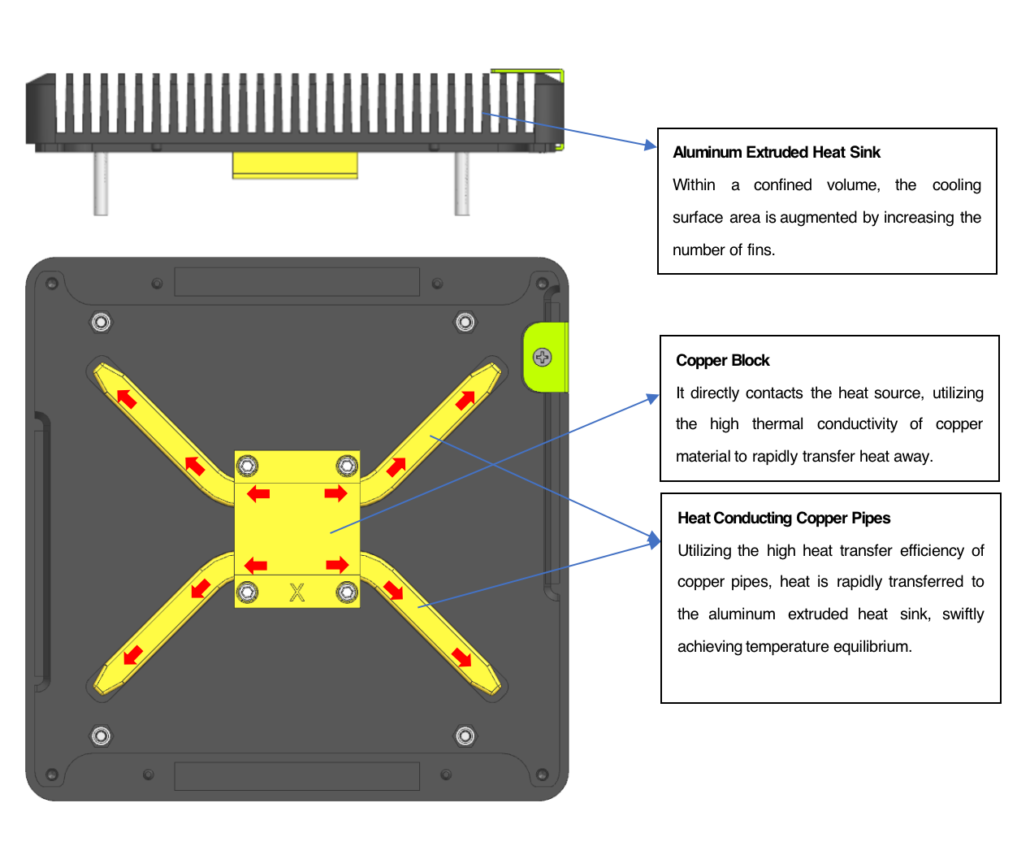
Full load thermal testing, environment temperature at ~25°C
Jetson Xavier NX module + reComputer Industrial Enclosure, working @20W measured current 2.0A
| Testing time/ Temperature | AO | AUX | CPU | GPU | THERMAL | Internal Thermal Copper Block | Ambient Environment | Enclosure |
| 15:17 | 36 | 35.5 | 38.5 | 38.5 | 37.5 | 38 | 25 | 61 |
| 16:42 | 59 | 58.5 | 61.5 | 60.5 | 60 | 59.4 | ||
| 16:56 | 59 | 59 | 61.5 | 61 | 60.35 | 59.8 |

Jetson Orin NX module + reComputer Industrial Enclosure, working @25W measured current 1.67A, testing starts from 9:30
| Testing time/ Temperature | CPU | GPU | SOC0 | SOC1 | SOC2 | TJ | Enclosure | Ambient Environment |
| 13:48 | 62 | 60 | 60.44 | 60.5 | 59.5 | 62 | 55.5 | 27 |

Jetson Orin NX module + reComputer Industrial Enclosure, working @25W measured current 1.67A, testing starts from 9:30
| Orin NX @MAXn power mode, measured current 2.71A, start from 12:00 | ||||||||
| Testing time/ Temperature | CPU | GPU | SOC0 | SOC1 | SOC2 | TJ | Enclosure | Ambient Environment |
| 13:30 | 74 | 73 | 77 | 72 | 71 | 74 | 68 | 27 |
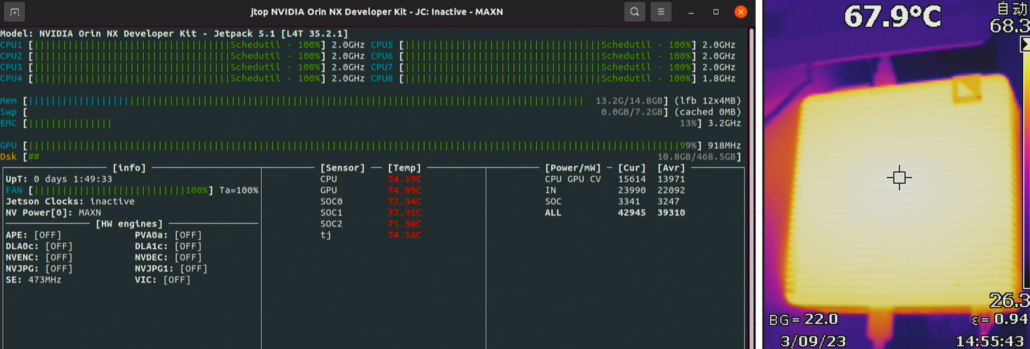
Full load thermal testing, environment temperature at 45~60°C
Jetson Xavier NX module + reComputer Industrial Enclosure, at ambient temperature 60°C
CPU temperature: 82.5°C
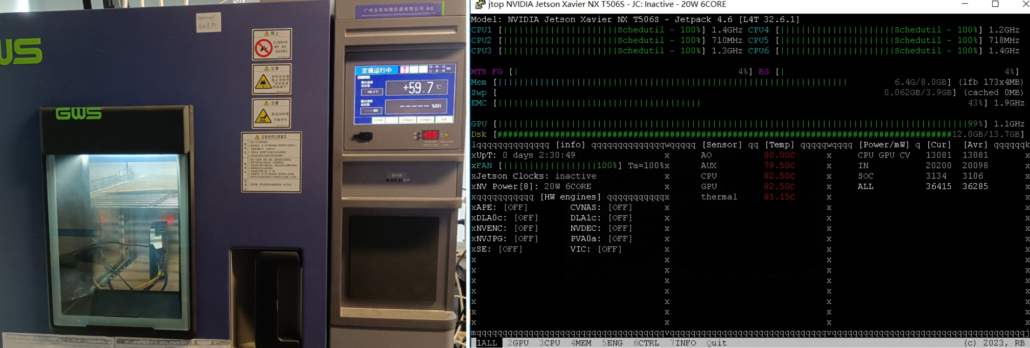
Jetson Orin NX module + reComputer Industrial Enclosure, Ambient Temperature 45°C
- Placed in the upper compartment of a temperature chamber, the system’s own airflow is tested.
- CPU temperature: 62.84°C

- Placed in the lower compartment of a temperature chamber, the system’s own airflow is tested with a partition.
- CPU temperature: 80.62°C
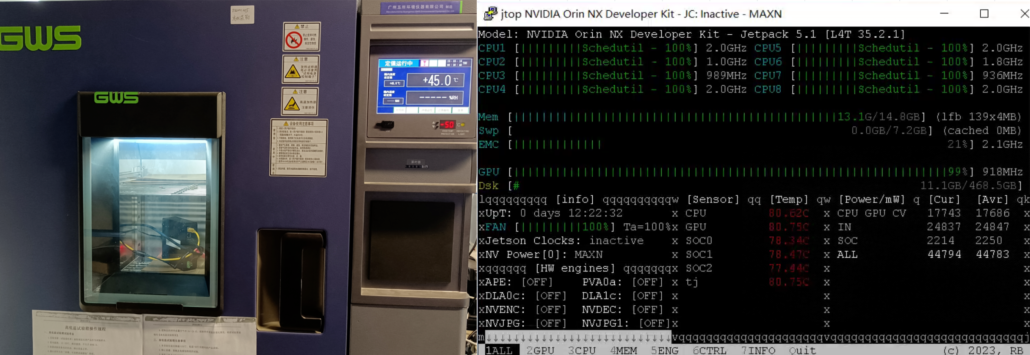
Jetson Orin NX module + reComputer Industrial Enclosure, Ambient Temperature 50°C
- Placed in the upper compartment of a temperature chamber, the system’s own airflow was tested.
- CPU temperature: 68.03°C
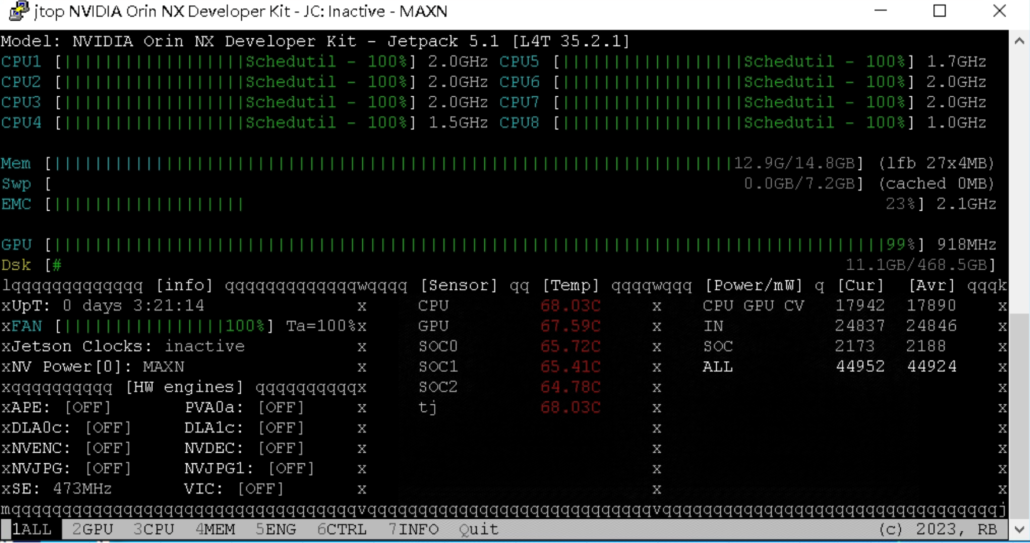
- Placed in the lower compartment of a temperature chamber, the system’s own airflow was tested with a partition.
- CPU temperature: 86.34°C
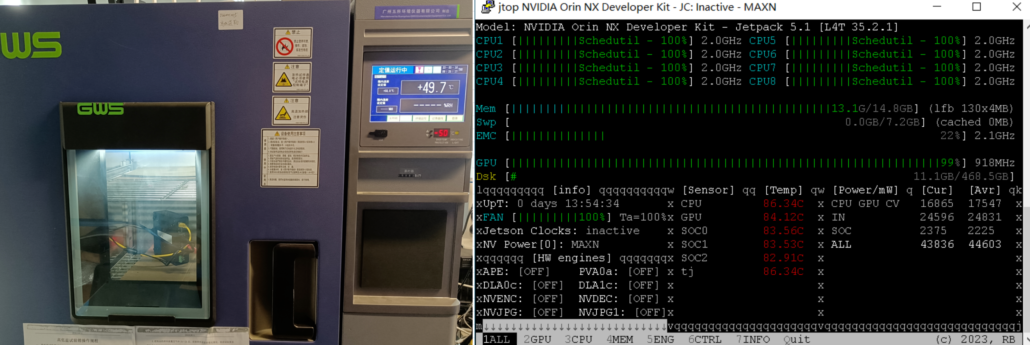
Jetson Orin NX module + reComputer Industrial Enclosure, Ambient Temperature 60°C
- Placed in the upper compartment of a temperature chamber, the system’s own airflow was tested.
- CPU temperature: 79°C
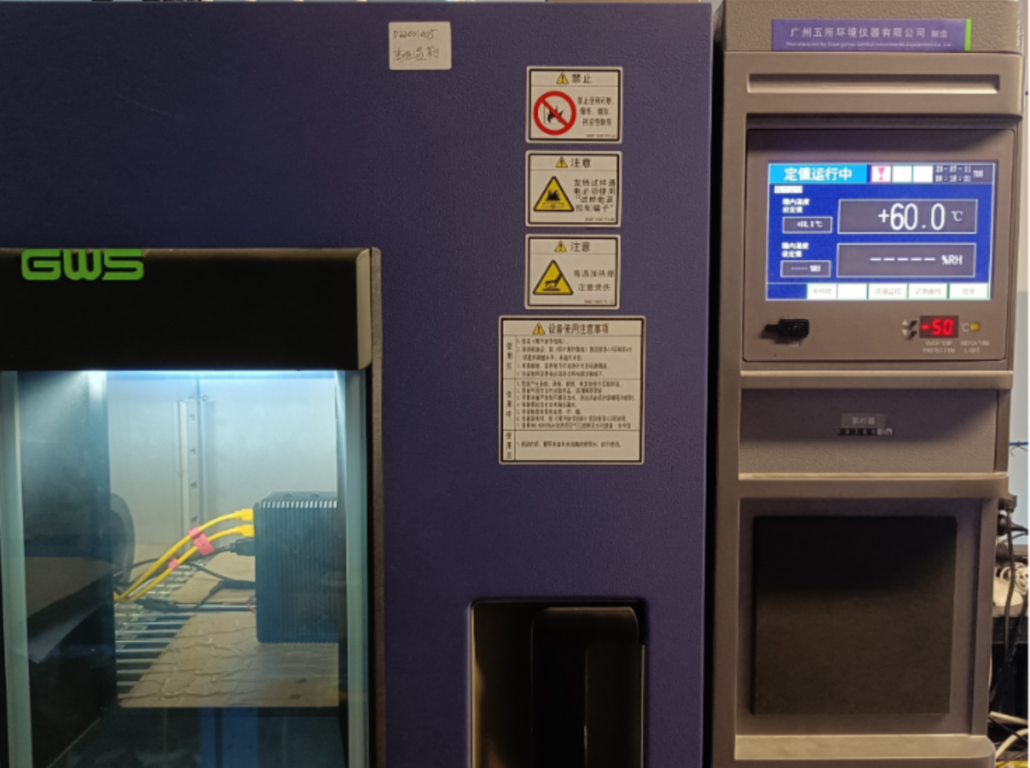
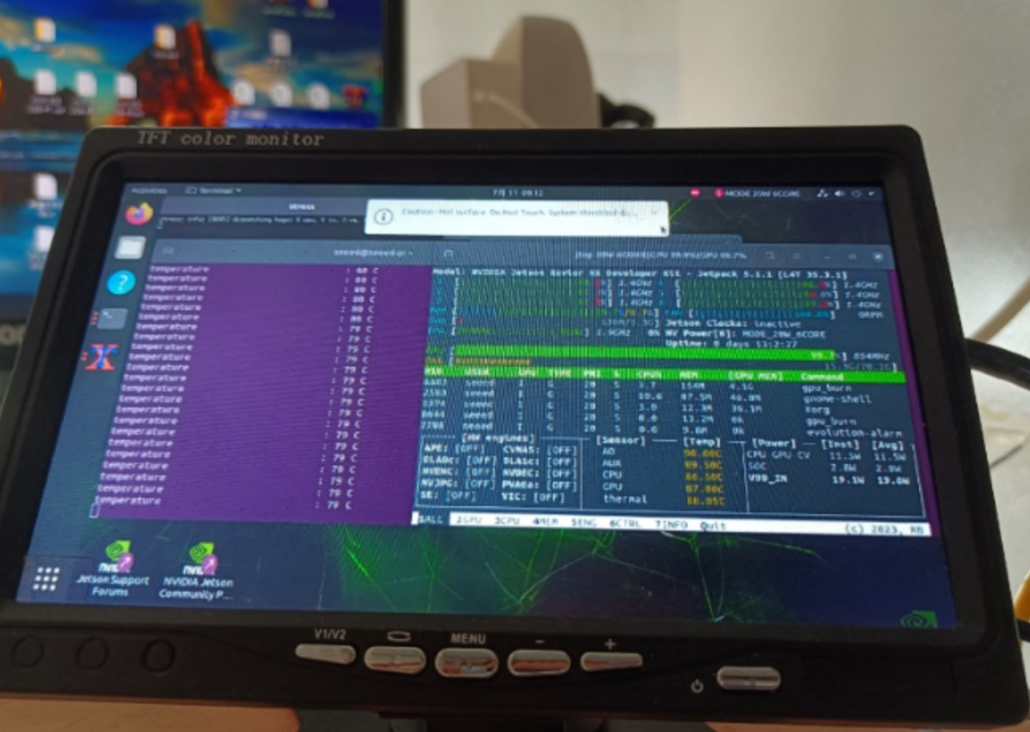
Agile manufacturing from 0.1 to ∞, custom service for NVIDIA Jetson series
Seeed Agile ODM Service empowers device makers and integrators with our customizable services tailored to their specific hardware needs, including form factors, image flashing, and logo change. Our comprehensive services reduce time-to-market for customers by handling all aspects of the process, from licensing and integration to manufacturing, fulfillment, and distribution.
Seeed ODM Custom Design for NVIDIA Jetson includes:
- Customize your own reComputer with a custom carrier board based on J401;
- Image flashing service for reComputer series;
- Customize with your logo on reComputer J30/J40 series.
Seeed Studio One-stop ODM service

Seeed NVIDIA Jetson Ecosystem

Seeed is an Elite partner for edge AI in the NVIDIA Partner Network. Explore more carrier boards, full system devices, customization services, use cases, and developer tools on Seeed’s NVIDIA Jetson ecosystem page.
Partner with us!
Join the forefront of AI innovation with us! Harness the power of cutting-edge hardware and technology to revolutionize the deployment of machine learning in the real world across industries. Be a part of our mission to provide developers and enterprises with the best ML solutions available. Check out our successful case study catalog to discover more edge AI possibilities!
Take the first step and send us an email at [email protected] to become a part of this exciting journey!
More Resources
- Jetson Orin NX Series and Jetson Orin Nano Series – Thermal Design Guide, by NVIDIA
- Seeed’s NVIDIA Jetson Platform to Be Manufactured in Vietnam
- Find everything about Seeed’s Jetson on the ecosystem page
- Download our latest Jetson Catalog to find one option that suits your projects.
- If you can’t find the off-the-shelf Jetson hardware solution for your needs, please check out our customization services, and submit a new product inquiry to us at [email protected] for evaluation.
- Find all useful developer tools at our wiki, we help you get started with AI projects easily!